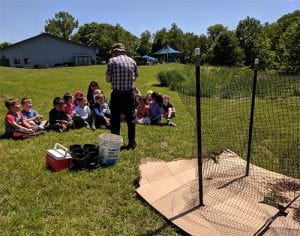On May 15, “Chestnut Day” at the Butler Montessori School in Darnstown, Maryland, MD-TACF Chapter member Gary Carver led a program to plant American chestnut trees and talk with young students about the trees and the work of TACF.
The first group of 40 first, second, and third graders, helped plant four American chestnut seedlings on the school grounds. Gary began by asking the students to tell him the names of trees they can identify. After many of them named different trees they were familiar with, he told them about the American chestnut and how it was once the most common and largest tree in Maryland. Since they were familiar with the three Chinese chestnut trees growing on campus, he engaged them in a discussion of the difference between the American and Chinese chestnut trees and showed them burs and nuts from both species. He then explained why there are hardly any American chestnut trees left, showed them sections of stems with cankers, and talked about why it is important for both wildlife and people that the tree is restored.

Gary talks to the youngest students at the school about the chestnut seeds they will plant in pots.
After planting two trees at one site, with short tubes to protect against rodents and fencing to protect against deer, everyone walked to another location to plant two additional seedlings. At that site, Gary spoke about how trees grow, then he gave out chestnut cookies. The students, who knew about annual rings, had fun counting them on their cookies to figure out the age of the trees.
The second group of 60 students were even younger, some as young as three years old. Gary engaged them in a discussion about trees, American chestnuts, and the tree disease that killed most of them. He explained that chestnut trees are being planted in order to bring them back so that people will have good wood to work with as well as provide food for animals and people alike. After showing them a seed that was ready to be planted, the students helped plant the seeds in pots to grow in the school’s greenhouse. They were especially eager to use their fingers to make a hole in the potting mix for the radicle and to pinch the potting mix around it before adding more mix to cover the seed.
